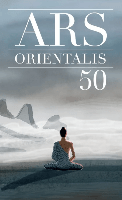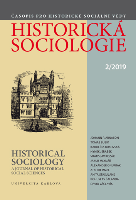
International Journal for History, Culture and Modernity
Scope & Guideline
Navigating the Complexities of Society Through Time
Introduction
Aims and Scopes
- Interdisciplinary Historical Analysis:
The journal encourages the integration of diverse methodologies from history, cultural studies, and social sciences to understand historical phenomena and their contemporary relevance. - Cultural Representations and Memory:
There is a strong emphasis on how cultural artifacts, narratives, and practices shape collective memory and identity, often exploring visual and textual representations across different periods. - Post-Colonial and Subaltern Studies:
A recurring theme involves examining colonial histories and the voices of marginalized groups, aiming to amplify subaltern perspectives and challenge dominant historical narratives. - Modernity and Its Discontents:
The journal frequently engages with the concept of modernity, questioning its implications and the transformations it brings to societal structures, identities, and cultural practices. - Critical Engagement with National Myths:
Explorations of national identity and myths play a crucial role, scrutinizing how these narratives are constructed, maintained, and challenged within historical contexts.
Trending and Emerging
- Visual Culture and Representation:
Recent publications increasingly focus on visual narratives, exploring how photography and other visual media shape historical understanding and cultural representation. - Subaltern Voices and Agency:
There is a growing emphasis on subaltern studies, particularly in understanding the agency of marginalized groups in historical narratives, reflecting a broader commitment to social justice in scholarship. - Historical Consciousness and Memory Studies:
Themes related to historical consciousness and the uses of the past have gained traction, exploring how societies remember and interpret their histories amidst contemporary challenges. - Intersections of Culture and Politics:
The journal is increasingly addressing the intersections between culture and political movements, examining how cultural practices influence and reflect political ideologies. - Global Perspectives on Modernity:
Emerging discussions are expanding the understanding of modernity beyond Eurocentric frameworks, incorporating diverse global perspectives and experiences.
Declining or Waning
- Traditional Historical Narratives:
There appears to be a decline in emphasis on conventional historical narratives that prioritize grand historical events over individual or localized experiences. - Eurocentric Perspectives:
The journal has gradually moved away from a predominantly Eurocentric viewpoint, reflecting a broader trend in academia towards inclusivity and global perspectives. - Static Interpretations of Modernity:
Earlier works that engaged with modernity in a static or uncritical manner are less common, suggesting a shift towards more dynamic and critical approaches to understanding modernity. - Limited Focus on Nationalism:
While nationalism has been a significant theme, recent publications indicate a waning interest in nationalism as an isolated topic, favoring instead discussions that integrate nationalism with broader cultural and historical contexts.
Similar Journals

Teksty Drugie
Unveiling New Perspectives in Literary StudiesTeksty Drugie is a premier academic journal dedicated to the field of Literature and Literary Theory, published by the Polish Academy of Sciences, Institute of Literary Research. With its issuance beginning in 2008 and extending intermittently to 2020, this journal has been a significant contributor to literary scholarship in Poland and beyond. The journal holds a commendable Q2 ranking in its category for 2023, indicating its influential status amongst peers in the Arts and Humanities realm, and an impressive Scopus rank of #736 out of 934 in the Literature and Literary Theory domain, with a 21st percentile ranking. Researchers and students will find this journal invaluable for its rigorous academic standards and insightful contributions to contemporary literary discourse. While traditionally available through subscription, Teksty Drugie remains an essential resource for those engaged in the study of literature, offering critical theoretical perspectives and a forum for scholarly debate. The journal is located at ul. Nowy Świat 72, Pałac Staszica, Room 1, Warszawa 00-330, Poland.

Cercles-Revista d Historia Cultural
Bridging perspectives in the humanities since 1998.Cercles-Revista d Historia Cultural is a vital scholarly platform published by UNIV BARCELONA, SERVEI PUBLICACIONS, dedicated to advancing the field of cultural history through accessible research. With its Open Access model established in 1998, this journal encourages the wide dissemination of knowledge, providing a valuable resource for researchers, professionals, and students alike. Based in Barcelona, Spain, Cercles competes in the Q4 quartile rankings for both Cultural Studies and History as of 2023, and is significant within its niche, despite recent challenges reflected in its Scopus rankings and percentiles. The journal covers a spectrum of topics, promoting interdisciplinary dialogue and critical perspectives in cultural history. Aimed at fostering scholarly engagement, Cercles represents an important avenue for academic discourse and dissemination in the humanities.

Revista Tefros
Bridging Disciplines, Enriching UnderstandingRevista Tefros is a premier academic journal published by UNIV NACL RIO CUARTO and TALLER ETNOHISTORIA FRONTERA SUR, focusing on the interdisciplinary fields of social sciences and humanities with a particular emphasis on ethnography and cultural studies. Since its launch in 2005, this Open Access journal has provided an invaluable platform for researchers, professionals, and students to disseminate their findings and engage with innovative scholarship. With an ISSN of 1669-726X and an E-ISSN of 1667-9229, Revista Tefros invites contributions that explore diverse cultural narratives and social dynamics, thereby enriching the academic dialogue. The journal is dedicated to promoting accessibility in research publication, ensuring that valuable insights are available to a broader audience. As part of its commitment to excellence, the journal strives to uphold high standards of scholarship and aims to contribute meaningfully to the academic community in Argentina and beyond.

ARS Orientalis
Advancing Understanding in Archaeology and Cultural StudiesARS Orientalis is a distinguished academic journal published by the Smithsonian Institution's Freer Gallery of Art, specializing in the fields of archaeology, cultural studies, and the visual and performing arts. With an ISSN of 0571-1371, this journal contributes significantly to scholarly discourse, having established a robust timeline of publication since its inception, notably from 2001 to 2006, 2010 to 2012, 2014 to 2017, and resuming again from 2022 to 2023. Though currently not open access, it maintains a respectable standing in the academic community with a categorization into Q3 quartiles across several disciplines, highlighting its relevance amid rigorous scholarly evaluation. The journal is particularly valuable for researchers, professionals, and students who seek to explore interdisciplinary connections within its scope. Situated in the United States, it aims to disseminate insightful research that bridges the gap between traditional scholarship and contemporary studies in visual culture and archaeological findings.

Tempo e Argumento
Fostering Innovative Narratives in HistoryTempo e Argumento is a distinguished academic journal dedicated to the field of History, published by the Universidade do Estado de Santa Catarina (UDESC), Brazil. Since its inception in 2009, this Open Access journal has aimed to foster scholarly dialogue and disseminate research findings that contribute to historical discourse and understanding. With a commendable Q1 classification in the 2023 category quartiles and a current rank of #940 in Scopus for Arts and Humanities - History, it stands out for its commitment to high-quality academic output. The journal invites contributions from diverse perspectives, promoting innovative discussions among researchers, professionals, and students alike. Scholars can find the journal's articles freely accessible, enhancing the visibility and impact of their work. For those interested in the evolving narratives of history, Tempo e Argumento provides an essential platform for exploration and inquiry.

Memoria y Civilizacion-Anuario de Historia
Championing Quality Research in HistoryMemoria y Civilizacion-Anuario de Historia, published by UNIV NAVARRA, SERVICIO PUBLICACIONES, is a prestigious open-access journal that has been serving the academic community since 1998. With a focus on historical research, this journal contributes significantly to the field by offering a platform for scholars to disseminate their findings and engage in critical discussions. With its Q1 ranking in History for 2023 and a solid position in the Scopus listings (Rank #905/1760), it underscores its importance in the humanities, ensuring that quality research reaches a wide audience. The journal is based in Spain and is committed to open access, providing free availability of its content to promote wider dissemination of knowledge. Researchers, professionals, and students alike will find Memoria y Civilizacion-Anuario de Historia to be an indispensable resource for historical inquiry and scholarship.

Lithuanian Historical Studies
Decoding the Cultural and Historical Fabric of LithuaniaLithuanian Historical Studies is a respected academic journal published by BRILL, focusing on the nuanced exploration of cultural, historical, and sociopolitical dynamics within Lithuania and its historical context. With an ISSN of 1392-2343 and an E-ISSN of 2538-6565, this journal aims to disseminate scholarly research that contributes to the understanding of Lithuania's cultural heritage and historical developments. Although it operates without an open-access model, its content is essential for researchers, professionals, and students interested in History, Cultural Studies, and Religious Studies. Ranked in the fourth quartile across several categories in 2023, including Cultural Studies and Sociology and Political Science, it provides a platform for academic discourse among those researching in the field. Despite its modest Scopus rankings, it plays a critical role in advancing knowledge within these disciplines and fostering dialogue across them, making it a valuable resource for anyone engaged in the study of Lithuanian or broader Eastern European history.

Anclajes
Exploring the Depths of Culture and ExpressionAnclajes is a prominent academic journal dedicated to the fields of Cultural Studies, Linguistics, and Literature, published by the UNIV NACIONAL LA PAMPA, FAC CIENCIAS HUMANAS. With both print (ISSN 0329-3807) and electronic (E-ISSN 1851-4669) formats, the journal has embraced an Open Access model since 2010, greatly enhancing its accessibility and reach to a global audience. Based in Argentina, Anclajes provides a platform for innovative research and critical discourse, contributing significantly to the understanding of cultural phenomena and literary theories. In recent years, the journal has established itself with a Scopus rank placing it in the top 30% of Literature and Literary Theory and the top 57% of Cultural Studies, as indicated by its quartile rankings for 2023. With issues converging from 2012 to 2024, Anclajes continues to foster scholarly communication and serves as an essential resource for researchers, students, and professionals seeking to explore the dynamism of human culture and expression.

ZEITGESCHICHTE
Decoding Contemporary Issues Through a Historical LensZEITGESCHICHTE, published by VANDENHOECK & RUPRECHT GMBH & CO KG, is a leading academic journal in the fields of Cultural Studies and History, distinguished by its Q2 ranking within the respective categories as of 2023. Based in Austria and serving a global audience, ZEITGESCHICHTE encompasses a broad range of interdisciplinary scholarly articles that examine historical context and cultural dynamics from various perspectives, contributing to a deeper understanding of contemporary issues rooted in the past. With a publication history dating back to 1976, the journal has evolved significantly, currently offering vital insights from 2006 to 2023, although it is not an open-access platform, ensuring that each piece maintains rigorous peer-review standards. This esteemed journal serves as an essential resource for researchers, students, and professionals seeking to navigate the intricate intersections of history and culture, reinforcing its importance in academic discourse.

Historicka Sociologie
Exploring the Nexus of History and SocietyHistoricka Sociologie is a distinguished academic journal published by CHARLES UNIV-PRAGUE, focusing on the interconnections between history, sociology, and cultural studies. Since its inception, the journal has embraced an Open Access model, allowing for unrestricted dissemination of knowledge to foster collaboration and innovation within the academic community. Based in the Czech Republic, it offers a vital platform for scholars to explore and discuss socio-historical phenomena, contributing to a deeper understanding of societal dynamics. The journal has been recognized within various category quartiles, achieving rankings of Q3 in History and Q4 in Cultural Studies and Sociology & Political Science as of 2023. With a commitment to enhancing scholarly discourse from 2016 to 2024, Historicka Sociologie continues to attract contributions that address pressing contemporary issues from a historical perspective, making it an essential resource for researchers, professionals, and students alike.